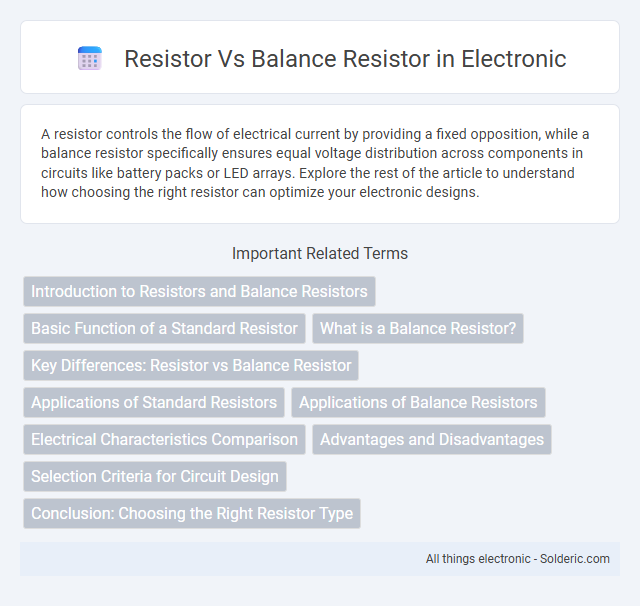A resistor controls the flow of electrical current by providing a fixed opposition, while a balance resistor specifically ensures equal voltage distribution across components in circuits like battery packs or LED arrays. Explore the rest of the article to understand how choosing the right resistor can optimize your electronic designs.
Comparison Table
| Feature | Resistor | Balance Resistor |
|---|---|---|
| Primary Function | Limits current and divides voltage | Equalizes voltage across cells in battery packs |
| Application | Circuit protection, signal conditioning | Battery management systems (BMS) |
| Resistance Value | Varies widely (ohms to megaohms) | Typically low to moderate (tens to hundreds ohms) |
| Power Rating | From milliwatts to watts | Usually low power dissipation |
| Special Characteristics | General purpose | Designed for voltage balancing and heat dissipation |
| Role in Circuit | Passive component for current control | Ensures uniform cell voltage in battery packs |
Introduction to Resistors and Balance Resistors
Resistors regulate electrical current by providing specific resistance values, essential for controlling voltage and current flow in circuits. Balance resistors, a specialized type of resistor, ensure equal voltage division or impedance matching in differential pairs and bridge circuits. Both components play critical roles in maintaining signal integrity and preventing circuit imbalance.
Basic Function of a Standard Resistor
A standard resistor primarily controls electrical current by providing a fixed resistance value to reduce or limit current flow within a circuit. It converts electrical energy into heat, ensuring voltage and current levels remain within desired parameters for sensitive components. Unlike balance resistors used in differential signaling or battery management, standard resistors serve fundamental roles in voltage division, current regulation, and signal conditioning.
What is a Balance Resistor?
A balance resistor is specifically designed to equalize voltage levels across multiple components in a circuit, often used in battery management systems to ensure uniform cell voltage. Unlike standard resistors, balance resistors minimize voltage imbalance by dissipating excess energy, thereby enhancing battery lifespan and safety. This specialized resistor plays a critical role in maintaining consistent performance and preventing overcharging in multi-cell configurations.
Key Differences: Resistor vs Balance Resistor
A resistor controls the flow of electric current by providing a specific resistance value in a circuit, whereas a balance resistor is specially designed to equalize voltage across multiple components, often in battery packs. Resistors typically manage current and voltage levels broadly, while balance resistors ensure uniform cell voltage to prevent overcharging or undercharging. Understanding the distinctions between these components helps optimize Your electronic circuit's performance and longevity.
Applications of Standard Resistors
Standard resistors are widely used in electronic circuits for current limiting, voltage division, and biasing components to ensure stable operation. They provide precise resistance values essential in applications such as signal conditioning, power regulation, and sensor calibration. Your designs benefit from standard resistors by achieving accurate control over electrical parameters in various consumer electronics and industrial devices.
Applications of Balance Resistors
Balance resistors are primarily used in applications involving voltage dividers, circuit balancing, and equalizing voltage across multiple components to improve stability and performance. They are essential in battery management systems to ensure uniform voltage distribution across series-connected cells, preventing overcharging or deep discharge. In precision measurement circuits, balance resistors enhance accuracy by minimizing offset errors caused by imbalance in sensor or amplifier inputs.
Electrical Characteristics Comparison
Resistors typically feature fixed resistance values chosen for general circuit current regulation, heat dissipation, and voltage division. Balance resistors, often used in differential circuits, maintain symmetric impedance to minimize noise and signal distortion by precisely matching resistance values across circuit branches. Electrical characteristics such as tolerance, temperature coefficient, and power rating are optimized in balance resistors to ensure stable, balanced signal paths, enhancing overall circuit performance compared to standard resistors.
Advantages and Disadvantages
A standard resistor provides stable and predictable resistance values essential for current regulation, but it may not compensate for voltage imbalances in multi-cell battery packs. Balance resistors are specifically designed to equalize cell voltages, improving battery longevity and safety, though they introduce continuous power dissipation and reduced overall efficiency. Choosing between the two involves weighing stability and simplicity against enhanced battery management and energy loss.
Selection Criteria for Circuit Design
Selection criteria for circuit design emphasize the resistor's resistance value, power rating, tolerance, and temperature coefficient to ensure stability and performance under expected operating conditions. A balance resistor is specifically chosen to evenly distribute voltage or current in bridge circuits, matching resistance values with minimal tolerance to maintain circuit symmetry and accuracy. Designers prioritize factors like matching impedance, power dissipation, and environmental stability when selecting balance resistors to optimize precision in measurement or load balancing applications.
Conclusion: Choosing the Right Resistor Type
Selecting the appropriate resistor type depends on the specific application requirements, with standard resistors suited for general current limiting and voltage division, while balance resistors are essential in circuits needing voltage equalization and precise current balancing. Balance resistors ensure stable operation in series-connected components such as batteries or transistors by minimizing voltage discrepancies. Careful consideration of tolerance, power rating, and circuit functionality is crucial for optimal performance and reliability.
resistor vs balance resistor Infographic

 solderic.com
solderic.com